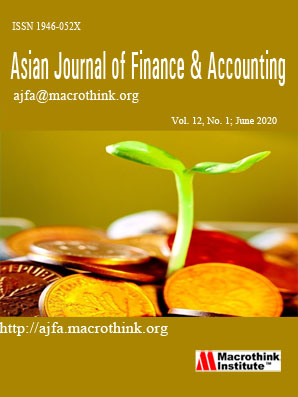Does Capital Structure Matter? The Influence of Capital Structure on Net Interest Margin: Evidence from Sri Lanka
Abstract
Objectives of this study were to examine the capital structure pattern of Sri Lankan commercial banks and to investigate the influence of capital structure on net interest margin of commercial banks in Sri Lanka. This study was conducted with 10 licensed commercial banks which are listed in Colombo Stock Exchange (CSE), Sri Lanka. Panel data analysis was used to carry out the empirical study and data were extracted from the annual reports of selected companies for the ten years period from 2007 to 2016. Capital structure patterns of licensed commercial banks were measured by total debt to total assets ratio, long term debt to total assets ratio, and short term debt to total assets ratio. Net Interest Margin (NIM) was measured by net interest income to average earnings assets ratio. NIM specifies the cost and efficiency of financial intermediation by banks. Size of the banks and growth in banks deposit were considered as control variables. Descriptive statistics, correlation, pooled, fixed effect and random effect models were used for the data analysis. According to the descriptive statistics, present study found that commercial banks had lower leveraged capital structure pattern in Sri Lanka. F test was performed to diagnose the time fixed effect in the fixed effect model and outcome of the test revealed that p value was less than 0.05. Therefore, null hypothesis was rejected and fixed effect model was most appropriate than pooled OLS. Further, Lagrange Multiplier test for random effect was performed. The result indicated that the p value was 0.000 and rejected the null hypothesis in favor of the alternative which implied that random effect model was more appropriate than pooled OLS. Therefore, Hausman Specification test was performed to find out whether fixed or random effect model is suitable to examine the relationship between capital structure and NIM. Fixed effect model was considered as the most suitable model to examine the influence of capital structure on NIM in this study. As per the result of fixed effect model, total debt to total assets ratio and long term debt to total asset ratio were significantly negatively related to NIM. Short term debt to total assets ratio, and size were not significantly related NIM. Results of the study suggest that financial managers should try to finance from retained earnings rather than relying heavily on debt capital in their capital structure. Outcome of the study may useful to the practitioners, investors and decision makers in order to maximize their return from their investments.
Submission of an article implies that the work described has not been published previously (except in the form of an abstract or as part of a published lecture or academic thesis), that it is not under consideration for publication elsewhere, that its publication is approved by all authors and tacitly or explicitly by the responsible authorities where the work was carried out, and that, if accepted, will not be published elsewhere in the same form, in English or in any other language, without the written consent of the Publisher. The Editors reserve the right to edit or otherwise alter all contributions, but authors will receive proofs for approval before publication.
Copyrights for articles published in MTI journals are retained by the authors, with first publication rights granted to the journal. The journal/publisher is not responsible for subsequent uses of the work. It is the author's responsibility to bring an infringement action if so desired by the author.








